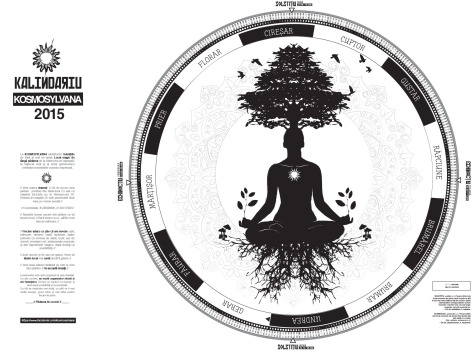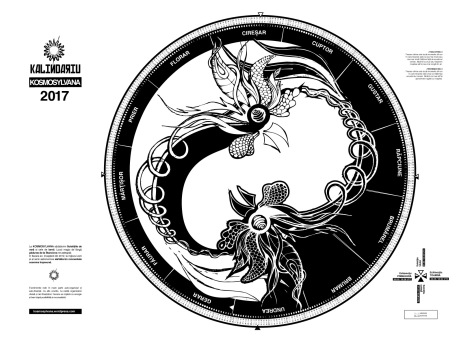So we’ve been designing the Kosmokalindar since 2014. For the first three the names of the months were in archaic Romanian. Now we go latin.


The 2017 kosmokalindar was a collaboration with an incredible illustrator of phantasy, Mona Babescu.
It was clearly a “guest” edition, the only calendar until now where we adapted one of the current mythologies, the Year of the Fire Rooster (2017 in Chinese Calendar). The other designs are not related to anything more then symbols, intuition and the understanding (or not understanding) of these.

They are all part of what we discovered and learned during those past years. A synthethis and a (hyper) story.
But each year, one or more human mistakes, or problems of time, if that’s possible – hid in the designs of the calendar, with hardly anyone noticing. Imagine this: I’ve been staring at the kalinders for long hours during their lingerings on a wall at home or at friends houses. I know them well.
The equinoxes — according to some laws and traditions, born through observation of time — are supposed to be at a 90 degree angle with the solstices. Some good visualisations of these are here.
Now, even if the .svg file placed in my calendar lunar precis 2018.ai file contains all the 365 days of the year arranged equally (with the help of programming) in the wheel of the year, the exact day and hour of the solstices and equinoxes don’t quite fit on the two axis.
So every year i’ve visually matched the arrows marking the two axis (vertical — summer / winter and horizontal — spring / autumn). I’m talking 2-3 mm on a 420 x 594 mm paper, but the difference is of 2-3 days around the equinox and 0.5 or 1 day around solstices. The exact day and UTC times are marked on the calendar and the arrows show towards those days. BUT they are not at a perfect 90 degrees angle as they “should” be.
The calendar is precise enough and its doing its job, As humans we dont perceive the imperfections so easily, if they are harmonious. Beauty is in the eye of the beholder, isn’t it. Plus, we are so used to angular designs that we might feel a bit lost — or eerily at home — in contemplating a circular one, so that little attention is paid to details like these.
Functionality, on the other hand, is the job of the creator.
In not perfectly aligning the geometrics to the purpose of this calindar, I acknowledge that I and what surrounds me is not perfect, but doesn’t need to be. Time is fluid. Sometimes it runs, sometimes it’s still.
(some rambling ahead >>>
Weather, climate and times are changing and we are adapting as we can by actually traveling through time/space on this spaceship called Mother Earth and by being alive.
As humans we are tiny, yet we feel omnipotent. Playing the Creator and the Destructor, Brahma and Shiva. Shakti and Kali.
The beauty of being human is that we can wear our heads in the stars while the earth (still) holds us, and learn all about it.
There is acceptance. )
Nevertheless, I am curious about how this technical problem that I /we are experiencing every year has a solution or at least if we can take it a few steps further. I am looking for someone to design an app for the Kosmokalindar or someone who can help make a closer-to-perfect aligned kalindar. Its both a challange and a kind request. And i’m talking Programmers. I.T. people. A.I. people. Magicians.
Or — is it because of the paradoxical nature of time and the commonly assumed conventions like leap years, like a month having more then the cycle of the moon but not all months having either 28, 29, 30 nor 31 days? Is this one of the reasons why we started using square calendars? So we dont’t have to see how discoherent our construct of time is? Must be. But not even these square ones (Gregorian, Julian, etc. ) are accurate.
Apparently there is no perfect calendar. And many have tried.
The frustration of not being able to understand time as not only circular or spiralling, but also unevenly distributed (?)
So, do send word if you think you can help.

P.S. — still trying to solve this problem on this year’s kalindar. The highly geometricalal and preciseness of the regular octagram — the skeleton of this year’s design — clearly not aligning perfectly to the times of the equinoxes, both being a wee bit below the horizontal line. So I havent sent it to print yet, trying to decide if i should leave it as it is or try to tweak the design so that the problem would not be noticed. I clearly found my answer by writing this article.
Tomorrow is forest day at Kosmosylvana, the winter solstice celebration ritual that we started at the End of the World as we knew it, in 21.12.2012. Its getting late in the wheel of the year, Christmas and weekends come fast, with leisure days and people not working so much. Anyway, it will be printed before New Year. Thats when the Kosmokalindar 2018 starts, so im hoping it will to reach its people soon enough.
Later edit: we solved the mistery, something I should have learned in school.
Earth’s orbit is not circular but eliptical and varies every year. That’s one way to dance in space.
